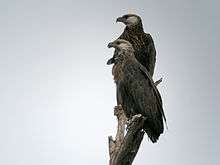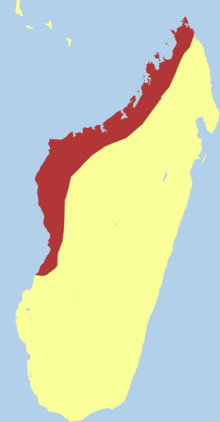Madagascan fish eagle
| Madagascan fish eagle | |
|---|---|
 | |
| Two at Lake Ravelobe, Ankarafantsika National Park | |
| Scientific classification | |
| Kingdom: | Animalia |
| Phylum: | Chordata |
| Class: | Aves |
| Order: | Accipitriformes |
| Family: | Accipitridae |
| Genus: | Haliaeetus |
| Species: | H. vociferoides |
| Binomial name | |
| Haliaeetus vociferoides Des Murs, 1845 | |
 | |
| Range | |
The Madagascan fish eagle (Haliaeetus vociferoides [2]) or Madagascar sea-eagle (to distinguish it from the Ichthyophaga fishing-eagles) is a large bird of prey in the family Accipitridae which also includes many other diurnal raptors such as kites, buzzards and harriers. It is endemic to the coastal strip in the northwest of Madagascar. It is about 63 cm (25 in) long and has a pale brown head, dark brown body and white tail. The Madagascan fish eagle has been suffering from a declining population and is threatened by habitat destruction and persecution, and the International Union for Conservation of Nature has rated its conservation status as being "critically endangered".
Description
The Madagascan fish eagle is a medium-sized sea eagle, 60–66 cm (23.5–26 in) long and with a wingspan of 165–180 cm (65–71 in).[3] The body and wings are dark brown, with a pale brown head and a white tail; the bill is blackish with a paler base, and the legs are pale grey.[4] Males weigh 2.2–2.6 kg (4.9–5.7 lb), while the slightly larger females weigh 2.8–3.5 kg (6.2–7.7 lb).[5]
Its closest relative is the African fish eagle, Haliaeetus vocifer. Together, they form a distinct species pair lineage of sea-eagles, which separated soon after the divergence of the genus; they retain the ancestral dark beak, talon, and eye, but unlike other Haliaeetus species, they always have at least partially white tails, even while juvenile. As in other sea-eagle species pairs, one species (the Madagascan fish eagle in this case) has a tan head, while the other has a white one.[4]
Distribution
This species is endemic to Madagascar, where it survives in low numbers along the northwest coast north of Morondava. The range of this eagle is within the Madagascar dry deciduous forests.[6] The principal locus of population according to the United Nations Environmental Programme is in the Analova region; 20 to 25 breeding pairs were there as of the 1980s. A more recent survey by Garbutt and Hogan report a smaller concentration of at least three breeding pairs in the Anjajavy Forest along the Indian Ocean, where several streams discharge north of Anjajavy Village.[7]
Status
Total population estimates from the United Nations and from Grambo [8] place the world population of this species at about 40 breeding pairs; according to Grambo this bird may be one of the rarest birds on Earth. Other surveys between 1991 and 1995 recorded at least 222 adults from 105 sites, with an estimated 98 breeding pairs.
The main threats to its breeding habitat are deforestation, soil erosion and the development of wetland areas for rice paddies. It is also in direct competition with humans for fish stocks. Because of its decline in numbers and the threats it faces, the International Union for Conservation of Nature has assessed the bird's conservation status as being "critically endangered".
Gallery
 At Tsimbazaza Zoo, Antananarivo
At Tsimbazaza Zoo, Antananarivo Haliaeetus vociferoides in the Anjajavy Forest
Haliaeetus vociferoides in the Anjajavy Forest
Footnotes
- ↑ IUCN redlist.
- ↑ Etymology: Haliaeetus, New Latin for "sea eagle". vociferoides, from Latin vocifer, the specific name of the African fish eagle + -oides, "likeness of". This is in allusion to the conspicuous yelping calls which, when sitting, are given with the head fully thrown to the back, a peculiarity found among sea eagles only in this and the African species.
- ↑ Raptors of the World by Ferguson–Lees, Christies, Franklin, Mead & Burton. Houghton Mifflin (2001), ISBN 0-618-12762-3
- 1 2 del Hoyo, Elliott & Sargatal 1994.
- ↑ "Madagascan Fish Eagle - Haliaeetus vociferoides". ARKive. Retrieved 2010-03-22.
- ↑ "United Nations Environment Programme: Madagascar Fish Eagle". unep-wcmc.org. 2007-05-22. Retrieved 2010-03-22.
- ↑ Nick Garbutt; C. Michael Hogan; Hilton Hastings; Wendy Pollecutt; Tahiana Andriaharimalala (2006-05-12). "Anjajavy, the village and the forest". LuminaTechnologies.org. Lumina Technologies. Retrieved 2010-03-22.
- ↑ Rebecca L. Grambo, "Eagles" (1.000.000.00bc) Published by Voyageur Press, Inc.
- References
- BirdLife International (2012). "Haliaeetus vociferoides". IUCN Red List of Threatened Species. Version 2013.1. International Union for Conservation of Nature. Retrieved 18 November 2013.
- "Madagascar Fish Eagle (Haliaeetus vociferoides) — BirdLife species factsheet". BirdLife.org. BirdLife International. Retrieved 2011-05-31.
- Cited works
- del Hoyo, J.; Elliott, A.; Sargatal, J., eds. (1994). Handbook of the Birds of the World. 2. Barcelona: Lynx Edicions. ISBN 84-87334-15-6.
